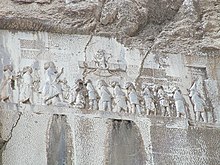Phraortes (rebel)
Phraortes ( Old Persian Fravartiš , Medo Frawartiš , Elamite Pirumartiš , Babylonian Parumartiš ; † .. 521 BC in Ecbatana ), son of Upadaranma was a self-proclaimed king of the Medes in the late 6th century BC. He was one of the eight so-called " kings of lies " who had risen against the seizure of power by Darius I.
After the death of the Persian great king Cambyses II and the overthrow of the short-term regent Bardiya / Gaumata by Dareios I in 522 BC. Revolts broke out in several provinces of the Persian Achaemenid Empire . The Medes, in whose province the overthrow had happened, rose up under the leadership of Phraortes, who presented himself as a descendant of the old Median ruling house and raised himself to King of the Medes under the throne name “Khšathrita”.
On the 27th day of the month of Anāmaka (January 12, 521 BC) Phraortes was defeated in a battle near Maruš south of Yazd by the Persian Hydarnes , but was able to escape from the battlefield and continue the rebellion. The Parthians and Hyrkanians allied with him were defeated by Hystaspes on the 2nd day of the month Viyakhna (March 8, 521 BC) . On the 25th day of the month of Adukanaiša (May 8, 521 BC), Phraortes was defeated this time by Darius I himself at Kunduruš near Bisutun a second time. He was able to flee again until he was finally caught in the Rhagai region . First his nose, ears and tongue were cut off and his eyes gouged out to demonstrate him as a deterrent example. He was then crucified in Ekbatana .
literature
- Albert T. Olmstead : Darius and his Behistun Inscription. in: American Journal of Semitic Languages and Literatures 55 (1938), pp. 392-416.
Remarks
- ^ Behistun-Inscription (DB), plate 2, §24 in: Roland G. Kent: Old Persian. Grammar, text, lexicon . American Oriental Society, New Haven (Conn.) 1953.
- ↑ Behistun inscription (DB), panel 2, §25.
- ^ Behistun inscription (DB), panel 2, §35.
- ^ Behistun inscription (DB), panel 2, §31.
- ^ Behistun inscription (DB), panel 2, §32.
| personal data | |
|---|---|
| SURNAME | Phraortes |
| ALTERNATIVE NAMES | Frawartiš; Fravartiš; Pirumartiš; Parumartiš |
| BRIEF DESCRIPTION | Median rebel king |
| DATE OF BIRTH | 6th century BC Chr. |
| DATE OF DEATH | 521 BC Chr. |
| Place of death | Ekbatana |
